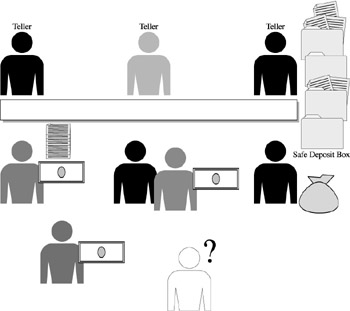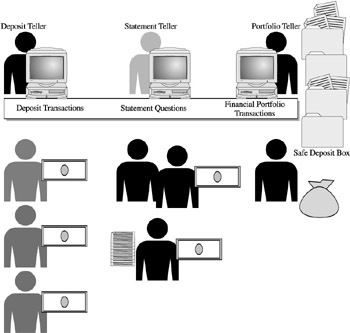The Definition and Characterization ofWorkloads
| |
The Definition and Characterization of Workloads
Workloads are traditionally defined as application processing modules that exhibit similar resource requirements, processing characteristics, and user expectations. Figure 17-1 further depicts this definition with its characterization of banking transactions. For example, at one time or other, weve found ourselves in a bank line with someone whos balancing their bank statement, applying for a car loan, and/or trying to find a missing check from, say, 1982, all at the same time. Their transaction, obviously, is much more resource- intensive than the deposit of your Grandmas birthday check.

Figure 17-1: An example banking transaction
So, if there were a categorization for the types of transactions the bank handles, everyone would get serviced more efficiently within a prescribed set of expectations. However, this would require the tellers to be categorized by the type of transaction they perform. Tellers would have appropriate resources at their disposal to deal with the transactions they service. There you have it, a simple workload categorization for the tellers, who, in this example, can also be characterized as servers (depicted in Figure 17-2).

Figure 17-2: Organizing workloads for maximum performance
The tellers have a set of resources and types of transactions they work on, giving certain kinds first priority. However, since these are all general-purpose tellers, they can work on any transaction should they run out of the particular type of work they are optimized for. Keep in mind that they are optimized for a particular type of workload and prioritize their work on that basis. Because of this, they may not handle a different workload as effectively as a peer teller that is optimized for a different type of transactional processing.
In this example, a simple transaction like depositing your Grandmas check can be taken care of by a teller, who functions similar to a computer transaction server that specializes in, and is optimized for, checking deposit transactions. The teller has the appropriate resources to process your deposit within a service time you are expecting. Other tellers process different transactions, such as safe deposit transactions (very physical, employing various resources), bank statement questions (very process-intensive, requiring much data), and financial portfolio transactions (multiple processes, compute-intensive with high priority).
| |
EAN: 2147483647
Pages: 192